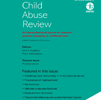Tag: child protection
-
New Directions in Child Protection and Wellbeing
Today is the last day of the BASPCAN Congress. Over the past three days I have had the privilege of meeting some awesome people from around the world – friends and colleagues old and new, united in one purpose: to make this world a better place for children. We have heard some inspiring talks, considered…
-

The challenge and complexities of physical abuse
The latest issue of Child Abuse Review has just been published, with a special focus on child physical abuse. On the background of high media interest in child abuse, there is some research evidence that rates of more severe physical abuse may actually have decreased. This suggests that, perhaps, our societies are becoming less tolerant…
-
Child abuse in fact and fiction: Seminar notes from ethics and children’s literature event, Warwick University, 2015
All children, except one, grow up. So said JM Barrie in the opening words of Peter Pan. Only it isn’t true. The reality is that far too many children never get the opportunity to grow up; or have to grow up before their time; or find…